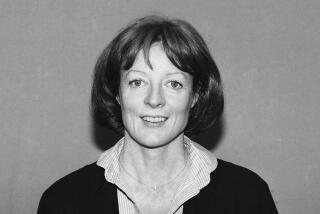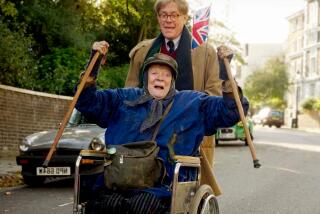A Film Maker’s War of Independence : Loretta Smith unites with Universal to finish Ron Kovic documentary
- Share via
For the last 15 years, independent film maker Loretta Smith has been a member of a very loose fraternity of globe-trotting nonconformists called the Lost Generation Brigade (their only rules: no meetings, no dues, no membership). Her life has put her in an orbit around wars, political movements, men who fight for causes and men who cause fights. Men like war hero-turned-war-protester Ron Kovic and other Brigade irregulars, including her ex-boyfriend, Richard Boyle.
Smith has gone to jail with Kovic and to extremes with Boyle. A free-lance journalist and photographer who has covered 20 wars, Boyle was the subject of the 1986 Oliver Stone film, “Salvador.” James Woods played him in a performance that went way over the top, “but he didn’t play him crazy enough,” Smith says, a laugh in her voice, perhaps remembering the time when Boyle talked her into going to Central America with no itinerary, no reservations and no money.
During the last five years, Smith’s life has been equally impoverished; she’s been fighting the riptides of independent film making to finish a documentary on Kovic. Her standard of living would appall a CAA client. Unpaid bills. Countless nights on friend’s couches. The never-ending search for funds. Smith, 42, a tiny, freckle-faced woman, finds that it keeps getting harder and harder to explain to friends why the telephone company keeps shutting off her phone.
“I feel as if my life has stopped for the last five years,” she says.
But it’s about to be jump-started. Although the big studios seldom bother with independent film makers, Smith signed a deal with Universal Studios last summer guaranteeing her distribution for her Kovic documentary and the money to finish it.
The Kovic connection has helped Smith too--Jane Fonda, Bruce Springsteen and Stone have all rallied to her aid--but what really turned up the voltage was a highly unusual circumstance: Universal also has a film on Kovic. Stone’s $15-million feature, “Born on the Fourth of July,” starring Tom Cruise as Kovic, will open this week, about the same time Smith planned to release her documentary, which she was also calling “Born on the Fourth of July.” It was a collision course that was bound to create ripples.
Last spring, Smith began hearing rumors that Universal was concerned about the conflict. Knowing that Universal held the big card--it owned the rights to the title and had the legal muscle to back it up--she worried that the powerful studio would try to crush her and her film would never be seen. Last April, she got together with Gerald Barton, Universal’s vice president of business affairs, and Smith’s worst fears turned out to be groundless.
In June, she says, Universal put what she considers a “reasonable offer on the table.” Basically, according to sources, the studio agreed to pay for the documentary’s completion--the last $50,000 of its $250,000 cost--and allow Smith to maintain full control over its content. The studio gets the American theatrical, home video and cable distribution rights. In return, Smith keeps public television, film festival and European rights; but she also agreed to change the title (she’s thinking of “Ron Kovic, American Patriot”) and to push back release of the documentary until next spring or summer.
But isn’t this Universal’s way of eliminating the competition?
“I’d rather not speculate on their motives,” Smith says. “I’m just looking at the deal as a very positive thing. It offers potential for distribution that most documentaries don’t get.”
The settlement also headed off a rift between Smith and Kovic, whose 15-year friendship has often been stormy. Kovic asked Smith to do the documentary but considers the feature, which he co-wrote with Stone back in 1978, to be a “more cathartic experience” and didn’t want Smith to even remotely jeopardize its chances. Eleven years earlier, he had become despondent when a “Born on the Fourth of July” version starring Al Pacino appeared ready to go but was never made.
Wearing a Guatemalan Indian blouse, Smith sits in the small living room of her rented Hollywood cottage. Cans of film on Kovic are stacked on top of an editing machine. Smith turns on her VCR and inserts a work-in-progress video, scenes narrated by Chicago writer Studs Terkel and culled from archival footage plus more than 50 hours of film that Smith has shot: Kovic maneuvering his way onto the floor--and national TV--at the 1972 Republican National Convention . . . Kovic wheeling down Broadway, waving a fist and singing Springsteen’s “Born in the U.S.A.” with other veterans . . . Kovic struggling at home in Redondo Beach, naked, graphically depicting the extent of his physical limitations.
Smith met Kovic in 1974 through Boyle, who had become fast friends with Kovic on the Last Patrol, a veterans’ convoy that converged on Miami to rage at Richard Nixon in 1972. She and Boyle were an unlikely couple, but their relationship “changed her whole life,” Boyle says with no hint of modesty. Second of six children in an Irish Catholic family, Smith grew up on the South Side of Chicago, liberal but unaware. “I didn’t know anything about the Vietnam War except that Buddhist monks were burning themselves,” she says. But she was swept into the peace movement.
Smith went to Washington in ’74 to attend a conference on Chile. She was in an elevator when Boyle entered her life. Noticing a camera around her neck, he struck up a conversation. Smith thought him “seasoned-looking and scruffy, a real intense character.” Boyle charmed her into a weekend fling. Smith thought it had ended until Boyle showed up in Chicago three weeks later for what he calls “a whirlwind romance.” She was living across from Wrigley Field and editing social studies books.
“It was a life of normalcy,” Boyle says. He asked her to quit her job, give away her apartment and her dog, sell everything she owned and drive him to Central America in her ’72 Datsun. She did. “He rescued me from a boring life,” Smith says today. But her euphoria didn’t last long. She says, “We didn’t get along.” From Mexico to Nicaragua, they argued over money. “His motto was ‘two can live as cheaply as one.’ We literally would eat off the same plate” and stay in $1-a-night dives.
After three months in Central America, they drove to Los Angeles. One night, Kovic showed up at a house where they were staying. Boyle had told Smith a lot about him, but Kovic still managed to surprise her. He had a stack of coffee-stained pages with him, the manuscript for a book, and he began to read aloud. Boyle fell asleep on the couch but Smith stayed up all night. “I couldn’t believe my ears,” she says. Published two years later, “Born on the Fourth of July” won the National Book Award and became a best-seller.
Despite their quarreling, Smith and Boyle stayed together for three years. They led a nomadic life, almost always staying with friends. “We lived without paying rent,” she says, still marveling. Smith was drawn into Kovic’s world, joining his inner circle.
In 1975, Smith, then a photo journalist, was drinking with Kovic and Boyle in Enrico’s Cafe, a North Beach bar in San Francisco, when someone came up with the idea of going to Cambodia to cover the end of the Vietnam War. Within days, they got free-lance assignments and took a plane to Bangkok. From Thailand, Kovic says, they got to the Cambodian border and “commandeered a taxi.” On the trip into Cambodia, they were stopped by the Khmer Rouge. The tense incident brought back cruel memories for Kovic and made him decide to return to the United States, but Smith and Boyle continued on. They wanted to cover the fall of Cambodia from Phnom Penh. That was glamorous. And dangerous.
“We sat on the balcony of the Royal Hotel watching the Khmer Rouge get closer every day,” Boyle recalls, “and I told Loretta to get out. She didn’t want to go--Loretta can be extremely stubborn--so I literally had to shove her on the last plane. I didn’t want to be responsible for her getting killed.” Boyle was later captured along with the New York Times’ Sydney H. Schanberg (who wrote the book that inspired “The Killing Fields”) and other journalists. Even today, Boyle says, “Loretta’s still mad at me” for forcing her to miss the action in Phnom Penh. Boyle, who now lives in Sierra Madre and is chairman of the Democratic Party in the San Gabriel Valley, imitates Smith yelling at him: “You didn’t get killed!”
After breaking up with Boyle in 1977, Smith went back home to Chicago and became a cabbie, quitting six years later when she was held up during Christmas week. She also enrolled at Chicago’s Columbia College film school. Her student project eventually evolved into in a 27-minute color documentary, “Where Did You Get That Woman?” It tells the story of Joan Williams, a 77-year-old black washroom attendant who worked in Chicago. The film won several awards, a citation from the Academy of Motion Picture Arts, and was aired on PBS.
In April, 1983, the documentary was shown at Filmex, and this time it was Kovic’s turn to be surprised. “I saw Loretta Smith the documentary film maker, and I was very impressed,” Kovic says. He also “instantly felt she was capable of doing an excellent documentary on me.” Besides, “I knew she would fight to get the film done.”
By October, 1984, Smith was out of debt from her first film and “Ron was really twisting my arm,” so she started the documentary with a $5,000 grant from the Illinois Arts Council. “Initially, I thought it would take a year to finish,” she says. “I thought I’d raise the money in nothing flat.” But in Reagan’s America, she says, grant money dried up instead. In 1985, “I was turned down for every grant I applied for. Government-sponsored agencies didn’t want to deal with war and veterans. Even celebrities didn’t. I sent out waves of letters but got no response.”
Then Kovic introduced her to Stone, also a Vietnam veteran. In December, 1985, Smith says, Stone “opened doors in L.A. for the film” by hosting a house party in Brentwood. About 75 people showed up, “but no celebrities or wealthy producers,” she says. “We only raised a little money but it was a great organizing night.”
But in early 1987, the documentary was only 30% shot and Smith had raised only $30,000. Then Stone, Tony Bill and Max Gail hosted a $300-a-plate fund-raiser at Bill’s Venice Beach restaurant, 72 Market Street. Serendipitously, the dinner came just hours after the announcement of the Academy Award nominations. That night, giddy from news of eight nominations for “Platoon” and another two for “Salvador” (including best original screenplay by Stone and Boyle), and moved by an 18-minute work-in-progress from the documentary, the crowd contributed $30,000, including $5,000 from Fonda and $10,000 from Springsteen, who also donated the use of “Born in the U.S.A.” and three other songs.
“Veterans were suddenly a chic cause” in Hollywood, says Smith, who has also received grants totaling $28,000 from the California Council for the Humanities.
Smith wasn’t the only one who initially thought the documentary wouldn’t take very long. Kovic believed her one-year timetable. But when the film dragged on Kovic became impatient, Smith says, and they argued frequently, often not talking for weeks. But such is their relationship that Kovic spent long hours at her hospital bed when she was recovering from an emergency appendectomy last spring.
One day soon Smith will make the final cut on the Kovic film, and the long struggle will be over. Kovic likes to tell a story that sums up what she’s gone through.
In May, 1979, with America on the brink of the Reagan Era, a sit-in at the University of Chicago was perhaps the last defiant act of the decade. Kovic led more than 250 students in a protest against a peace award given to former secretary of state Robert McNamara, an architect of the Vietnam War. When Chicago police grabbed Kovic’s wheelchair, students pulled it the opposite way, but they lost the tug of war. Kovic was thrown in a paddy wagon. Lying on the floor, he looked out at the crowd and saw Smith shoving past police.
“She jumps in there to help me,” Kovic recalls, “and they close the doors behind her. She can’t get out. What a perfect metaphor for the film.”
More to Read
Only good movies
Get the Indie Focus newsletter, Mark Olsen's weekly guide to the world of cinema.
You may occasionally receive promotional content from the Los Angeles Times.









